Paper Menu >>
Journal Menu >>
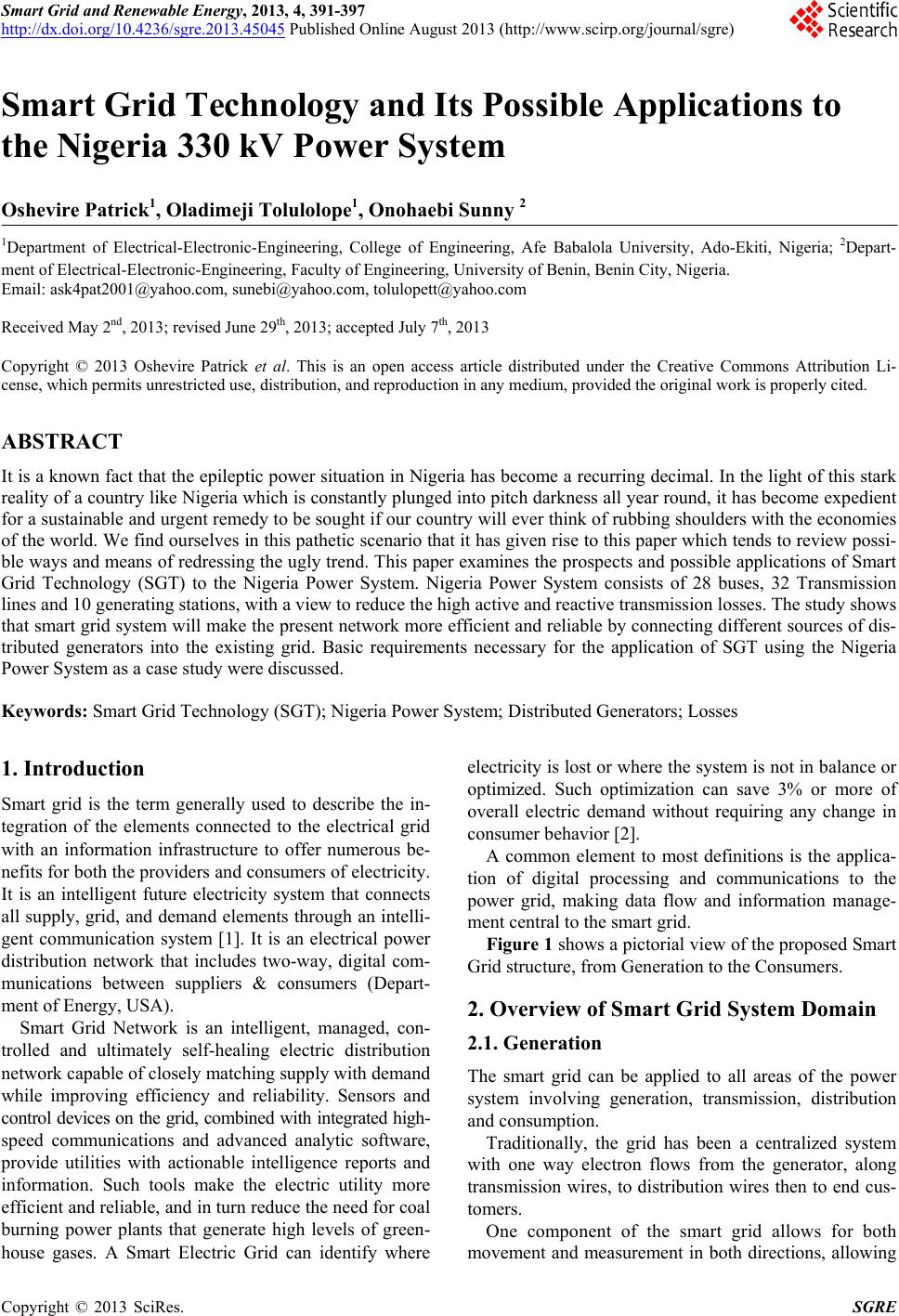 Smart Grid and Renewable Energy, 2013, 4, 391-397 http://dx.doi.org/10.4236/sgre.2013.45045 Published Online August 2013 (http://www.scirp.org/journal/sgre) Copyright © 2013 SciRes. SGRE 391 Smart Grid Technology and Its Possible Applications to the Nigeria 330 kV Power System Oshevire Patrick1, Oladimeji Tolulolope1, Onohaebi Sunny 2 1Department of Electrical-Electronic-Engineering, College of Engineering, Afe Babalola University, Ado-Ekiti, Nigeria; 2Depart- ment of Electrical-Electronic-Engineering, Faculty of Engineering, University of Benin, Benin City, Nigeria. Email: ask4pat2001@yahoo.com, sunebi@yahoo.com, tolulop ett@yahoo.com Received May 2nd, 2013; revised June 29th, 2013; accepted July 7th, 2013 Copyright © 2013 Oshevire Patrick et al. This is an open access article distributed under the Creative Commons Attribution Li- cense, which permits unrestricted use, distribution, and reproduction in any medium, provided the original work is properly cited. ABSTRACT It is a known fact that the epileptic power situation in Nigeria has become a recurring decimal. In the light of this stark reality of a country like Nigeria which is constantly p lunged into pitch darkness all year round, it h as become expedient for a sustainable and urgent remedy to be sought if our country will ev er think of rubbing sh oulders with the econo mies of the world. We find ourselves in this pathetic scenario that it has given rise to this paper which tends to review possi- ble ways and means of redressing the ugly trend. This paper examines the prospects and possible applications of Smart Grid Technology (SGT) to the Nigeria Power System. Nigeria Power System consists of 28 buses, 32 Transmission lines and 10 generating stations, with a view to reduce the high active and re a ctiv e tr an smission losses. The study shows that smart grid system will make the present network more efficient and reliable by co nnecting different sources of dis- tributed generators into the existing grid. Basic requirements necessary for the application of SGT using the Nigeria Power System as a case study were discussed. Keywords: Smart Grid Technology (SGT); Nigeria Power System; Distributed Generators; Losses 1. Introduction Smart grid is the term generally used to describe the in- tegration of the elements connected to the electrical grid with an information infrastructure to offer numerous be- nefits for both th e provid ers and consumers of electricity. It is an intelligent future electricity system that connects all supply, grid, and demand elements through an intelli- gent communication system [1]. It is an electrical power distribution network that includes two-way, digital com- munications between suppliers & consumers (Depart- ment of Energy, USA). Smart Grid Network is an intelligent, managed, con- trolled and ultimately self-healing electric distribution network capable of closely matching supply with demand while improving efficiency and reliability. Sensors and contro l device s on the gr id, combin ed with integrated high- speed communications and advanced analytic software, provide utilities with actionable intelligence reports and information. Such tools make the electric utility more efficient and reliable, and in turn reduce the need for coal burning power plants that generate high levels of green- house gases. A Smart Electric Grid can identify where electricity is lost or where the syste m is not in balance or optimized. Such optimization can save 3% or more of overall electric demand without requiring any change in consumer behavior [2]. A common element to most definitions is the applica- tion of digital processing and communications to the power grid, making data flow and information manage- ment central to the smart grid. Figure 1 shows a pictorial view of the proposed Smart Grid structure, from Generation to the Consumers. 2. Overview of Smart Grid System Domain 2.1. Generation The smart grid can be applied to all areas of the power system involving generation, transmission, distribution and consumption. Traditionally, the grid has been a centralized system with one way electron flows from the generator, along transmission wires, to distribution wires then to end cus- tomers. One component of the smart grid allows for both movement and measurement in both directions, allowing 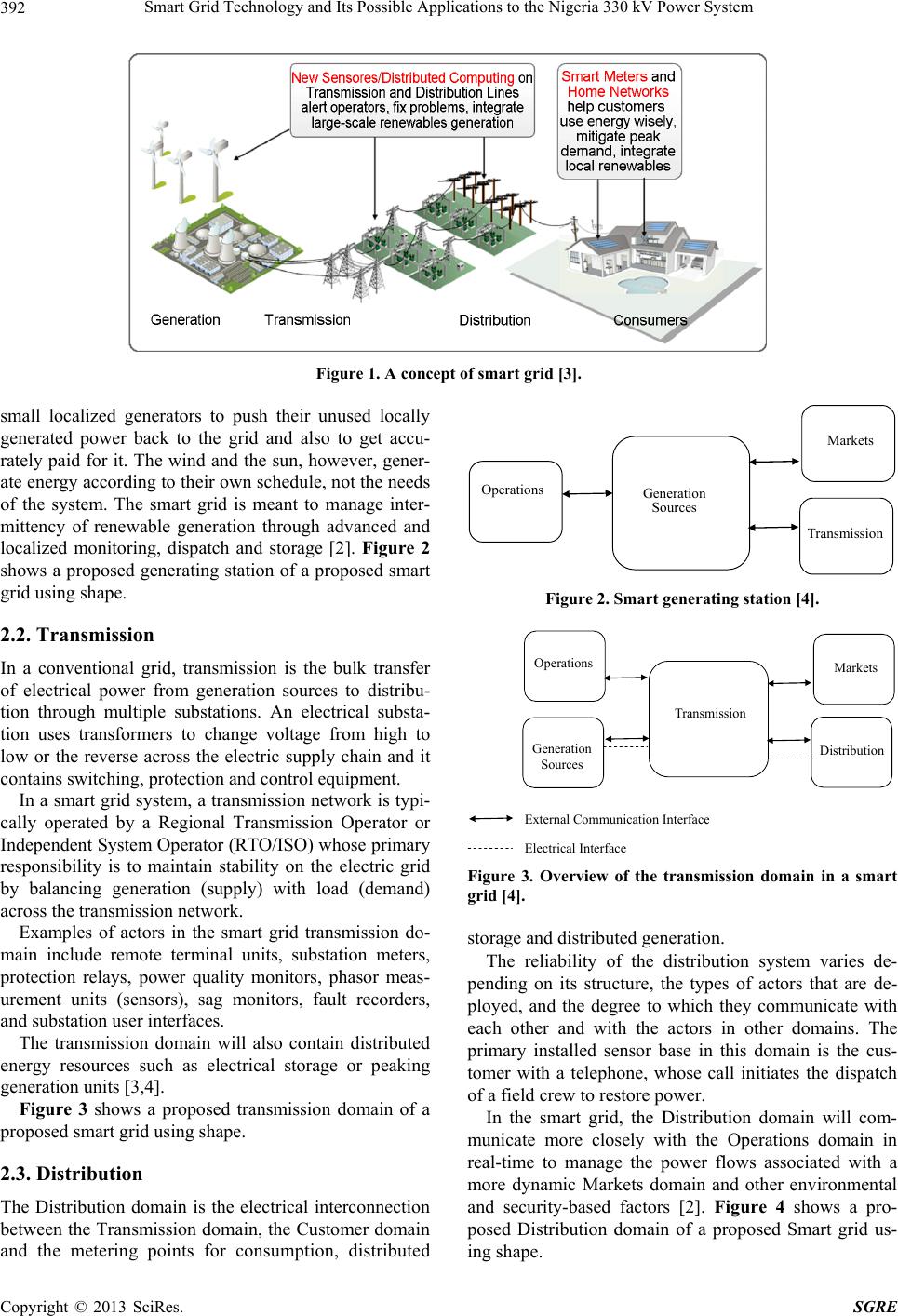 Smart Grid Technology and Its Possible Applications to the Nigeria 330 kV Power System Copyright © 2013 SciRes. SGRE 392 Figure 1. A concept of smart grid [3]. small localized generators to push their unused locally generated power back to the grid and also to get accu- rately paid for it. The wind and the sun, however, gener- ate energy according to their own schedule, not the needs of the system. The smart grid is meant to manage inter- mittency of renewable generation through advanced and localized monitoring, dispatch and storage [2]. Figure 2 shows a proposed generating station of a proposed smart grid using sha p e. 2.2. Transmission In a conventional grid, transmission is the bulk transfer of electrical power from generation sources to distribu- tion through multiple substations. An electrical substa- tion uses transformers to change voltage from high to low or the reverse across the electric supply chain and it contains switching, protection and control equipment. In a smart grid system, a transmission network is typi- cally operated by a Regional Transmission Operator or Independent System Operator (RTO/ISO) whose primary responsibility is to maintain stability on the electric grid by balancing generation (supply) with load (demand) across the transmission network. Examples of actors in the smart grid transmission do- main include remote terminal units, substation meters, protection relays, power quality monitors, phasor meas- urement units (sensors), sag monitors, fault recorders, and substation user interfaces. The transmission domain will also contain distributed energy resources such as electrical storage or peaking generation uni ts [3,4]. Figure 3 shows a proposed transmission domain of a proposed smart grid using shape. 2.3. Distribution The Distribution domain is the electrical interconnection between the Transmission domain, the Customer domain and the metering points for consumption, distributed Operations Generation Sources Markets Transmission Figure 2. Smart generating station [4]. Generation Sources Transmission Markets Distribution Operations External Communication Interface Electrical Interface Figure 3. Overview of the transmission domain in a smart grid [4]. storage and distributed generation. The reliability of the distribution system varies de- pending on its structure, the types of actors that are de- ployed, and the degree to which they communicate with each other and with the actors in other domains. The primary installed sensor base in this domain is the cus- tomer with a telephone, whose call initiates the dispatch of a field crew to restore power. In the smart grid, the Distribution domain will com- municate more closely with the Operations domain in real-time to manage the power flows associated with a more dynamic Markets domain and other environmental and security-based factors [2]. Figure 4 shows a pro- posed Distribution domain of a proposed Smart grid us- ing shape. 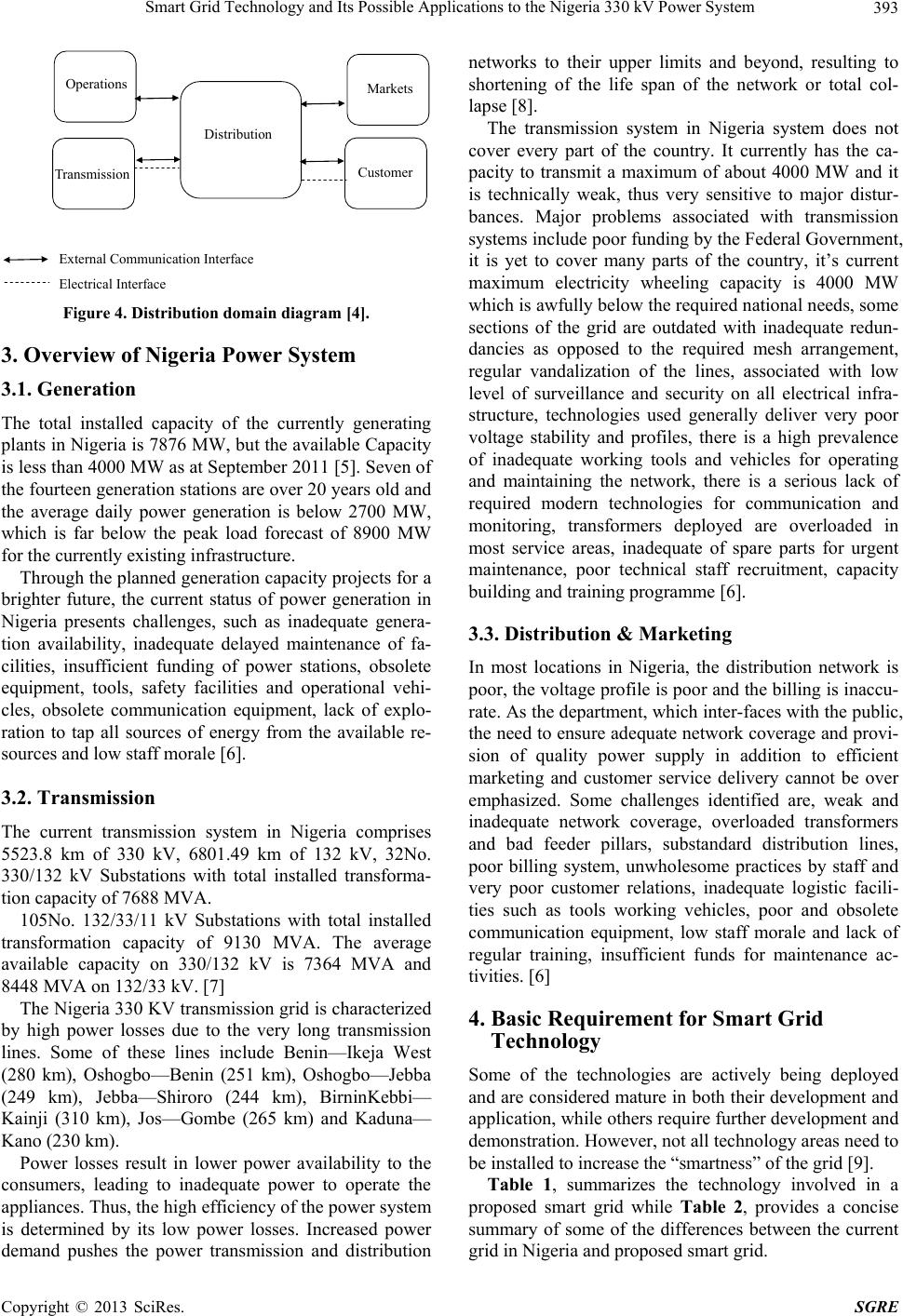 Smart Grid Technology and Its Possible Applications to the Nigeria 330 kV Power System Copyright © 2013 SciRes. SGRE 393 Transmission Distribution Markets Customer Operations External Communication Interface Electrical Interface Figure 4. Distribution domain diagram [4]. 3. Overview of Nigeria Power System 3.1. Generation The total installed capacity of the currently generating plants in Nigeria is 7876 MW, but the available Capacity is less than 4000 MW as at September 2011 [5 ]. Seven of the fourteen generation stations are over 20 years old and the average daily power generation is below 2700 MW, which is far below the peak load forecast of 8900 MW for the currently existing infrastructure. Through the planned generation capacity projects for a brighter future, the current status of power generation in Nigeria presents challenges, such as inadequate genera- tion availability, inadequate delayed maintenance of fa- cilities, insufficient funding of power stations, obsolete equipment, tools, safety facilities and operational vehi- cles, obsolete communication equipment, lack of explo- ration to tap all sources of energy from the available re- sources and low staff morale [6]. 3.2. Transmission The current transmission system in Nigeria comprises 5523.8 km of 330 kV, 6801.49 km of 132 kV, 32No. 330/132 kV Substations with total installed transforma- tion capacity of 7688 MVA. 105No. 132/33/11 kV Substations with total installed transformation capacity of 9130 MVA. The average available capacity on 330/132 kV is 7364 MVA and 8448 MVA on 132/33 kV. [7] The Nigeria 330 KV transmission grid is characterized by high power losses due to the very long transmission lines. Some of these lines include Benin—Ikeja West (280 km), Oshogbo—Benin (251 km), Oshogbo—Jebba (249 km), Jebba—Shiroro (244 km), BirninKebbi— Kainji (310 km), Jos—Gombe (265 km) and Kaduna— Kano (230 km). Power losses result in lower power availability to the consumers, leading to inadequate power to operate the appliances. Thus, the high efficiency of the power system is determined by its low power losses. Increased power demand pushes the power transmission and distribution networks to their upper limits and beyond, resulting to shortening of the life span of the network or total col- lapse [8]. The transmission system in Nigeria system does not cover every part of the country. It currently has the ca- pacity to transmit a maximum of about 4000 MW and it is technically weak, thus very sensitive to major distur- bances. Major problems associated with transmission systems include poor funding by the Federal Government, it is yet to cover many parts of the country, it’s current maximum electricity wheeling capacity is 4000 MW which is awfully below the required national needs, some sections of the grid are outdated with inadequate redun- dancies as opposed to the required mesh arrangement, regular vandalization of the lines, associated with low level of surveillance and security on all electrical infra- structure, technologies used generally deliver very poor voltage stability and profiles, there is a high prevalence of inadequate working tools and vehicles for operating and maintaining the network, there is a serious lack of required modern technologies for communication and monitoring, transformers deployed are overloaded in most service areas, inadequate of spare parts for urgent maintenance, poor technical staff recruitment, capacity building and training programme [6]. 3.3. Distribution & Marketing In most locations in Nigeria, the distribution network is poor, the voltage profile is poo r and the billing is inaccu- rate. As the department, which inter-faces with the public, the need to ensure adequate network coverage and provi- sion of quality power supply in addition to efficient marketing and customer service delivery cannot be over emphasized. Some challenges identified are, weak and inadequate network coverage, overloaded transformers and bad feeder pillars, substandard distribution lines, poor billing system, unwholesome practices by staff and very poor customer relations, inadequate logistic facili- ties such as tools working vehicles, poor and obsolete communication equipment, low staff morale and lack of regular training, insufficient funds for maintenance ac- tivities. [6] 4. Basic Requirement for Smart Grid Technology Some of the technologies are actively being deployed and are considered mature in both their develop ment and application, while others require further development and demonstration. However, not all technology areas need to be installed to increase the “smartness” of the grid [9]. Table 1, summarizes the technology involved in a proposed smart grid while Table 2, provides a concise summary of some of the differences between the current grid in Nigeria and proposed smart grid.  Smart Grid Technology and Its Possible Applications to the Nigeria 330 kV Power System Copyright © 2013 SciRes. SGRE 394 Table 1. Proposed smart grid technologies [9]. Technology Area Hard Ware Systems and Software Wide-area monitoring and control Phasor measurement units (PMU) and other sensor equipment like accelerometers, infrared sensors, strain guage and magnetic sensors. Supervisory control and data acquisition (SCADA), wide-area monitoring systems (WAMS), Grid lab view user interface. Information and communication technology integration Communication equipment (Power line carrier , WIMAX, LTE, RF mesh network, cellula r), routers, relays, switches, gateway, computers (servers) Enterprise resource planning software (ERP), customer information system (CIS) Renewable and distributed generation integration Power conditioning equipment for bulk power and grid support, communication and control ha rdware for generation and enabling storage technology Energy management system (EMS),distribution management system (DMS), SCADA, geographic Information system (GIS) Transmission enhancement Superconductors, Flexible AC Transmission Systems(FACTS), High Voltage Direct Current- Voltage Sourced Converter (HVDC-VSC), Sensors and Unified Power Flow Controller (UPFC) for voltage magnitude control, active and reactive power flow control. Network stability analysis, automatic recovery systems Distribution grid management Automated re-closers, switches and capacitors, remote controlled distributed generation and stor age, transformer sensors, wire and cable sensors Geographic information system (GIS), distribution management system (DMS), outage management system (OMS), workforce management system (WMS) Advanced metering infrastructure Smart meter, in-home displays, servers, relays Meter data management system (MDMS) Table 2. Difference betw een Nigeria networ k and proposed smart grid (compiled by Author). Criteria Nigeria Current Power Grid System Proposed Smart Grid Communications None or one-way; typically not real-time Two-way, real-time Customer interaction Limited Extensive Metering Mainly electromechanical Digital (enabling real-time pricing and net metering) Operation and maintenance Manual equipment checks. Remote monitoring, predictive, time-based maintenance Generation Majorly centralized stations Centralized and distributed Power flow control Limited Comprehensive, automated Reliability Prone to failur es and cascading outages; essentially reactive Automated, pro-active protection; prevents outages before they start Restoration following disturbance Manual Self-healing System topology Radial; generally one-way power flow Closed network; multiple power flow pathways Transmission/Distribution line losses Above ten percent (10%) loss of the total power in the transmission/distribution lines. About two percent (2%) loss of the total power in the transmission/distribution lines. 5. Requirements for Application of Smart Grid Technology in Nigeria Power System 5.1. Transmission Enhancement Equipment typically found in PHCN substations includes the following: switch gears, high rupturing capacity fuses (HRC), air-cored ring shielded reactors, lightening ar- resters, circuit breakers, power transformers, isolators, and bus bars, among other items, while the network com- ponents include power lines, cables, circuit breakers, switches, transformers, large size conductors, steel lattice towers, steel tubular poles, wooden poles, earthing equipment. In Nigerian transmission power system, it will become important to fully utilize the existing transmission facili- ties instead of building new power plants and transmis- sion lines that are costly to implement and involve long construction times. Flexible Alternating Current Trans- mission Systems (FACTS) controllers can be introduced in power systems to solve the above problems. FACTS make it possible to control the voltage magnitude of a bus, active and reactive power flows through transmis- sion line of a power system. Line sensors can also be introduced to monitor real time situations of the Network. 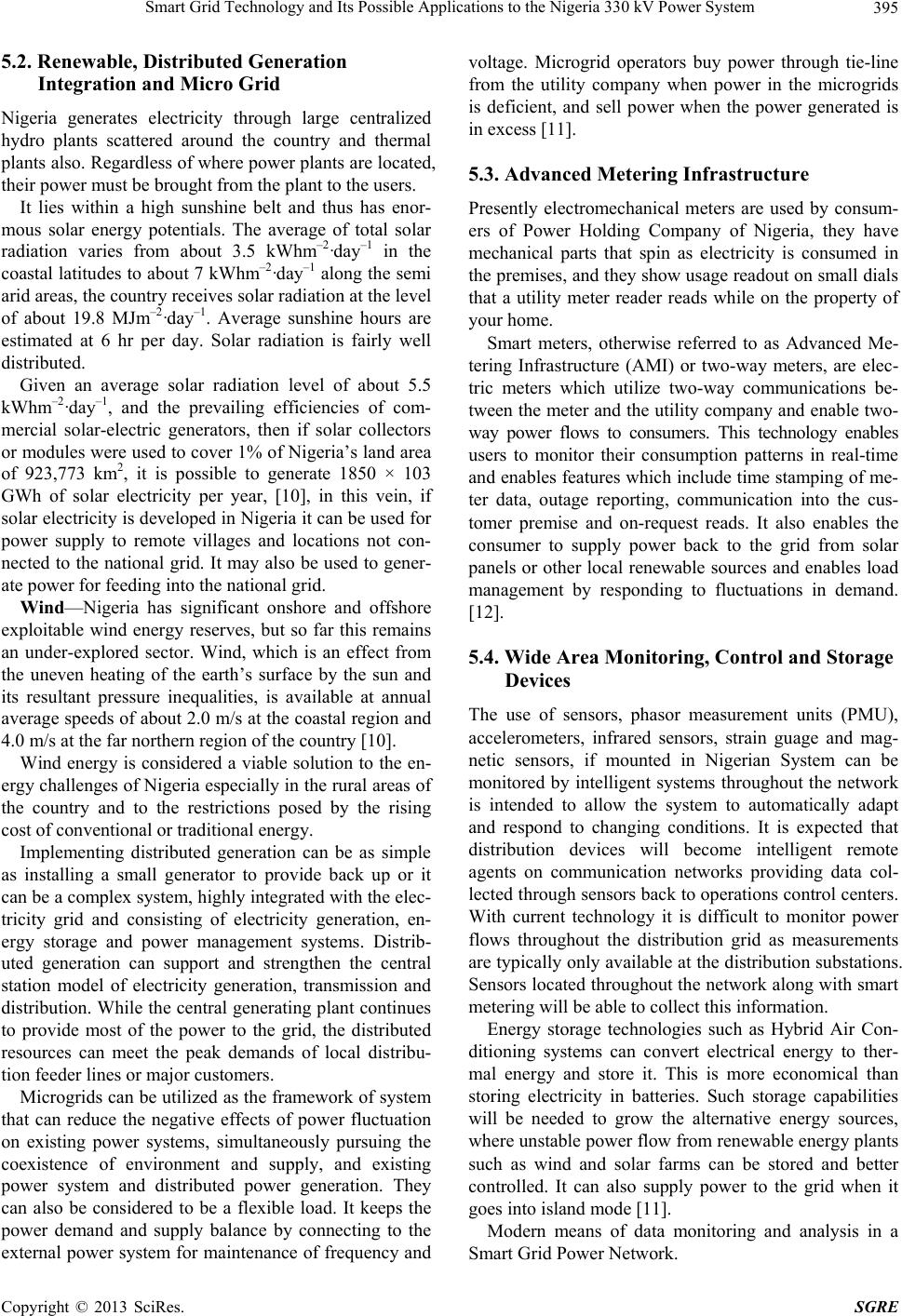 Smart Grid Technology and Its Possible Applications to the Nigeria 330 kV Power System Copyright © 2013 SciRes. SGRE 395 5.2. Renewable, Distributed Generation Integration and Micro Grid Nigeria generates electricity through large centralized hydro plants scattered around the country and thermal plants also. Regardless of where power plants are located, their power must be brought from the plant to the users. It lies within a high sunshine belt and thus has enor- mous solar energy potentials. The average of total solar radiation varies from about 3.5 kWhm–2·day–1 in the coastal latitudes to abou t 7 kWhm–2·day–1 along the semi arid areas, the country receives solar radiation at the level of about 19.8 MJm–2·day–1. Average sunshine hours are estimated at 6 hr per day. Solar radiation is fairly well distributed. Given an average solar radiation level of about 5.5 kWhm–2·day–1, and the prevailing efficiencies of com- mercial solar-electric generators, then if solar collectors or modules were used to cover 1% of Nigeria’s land area of 923,773 km2, it is possible to generate 1850 × 103 GWh of solar electricity per year, [10], in this vein, if solar electricity is developed in Nigeria it can be used for power supply to remote villages and locations not con- nected to the national grid. It may also be used to gener- ate power for feeding into the nation a l grid. Wind—Nigeria has significant onshore and offshore exploitable wind energy reserves, but so far this remains an under-explored sector. Wind, which is an effect from the uneven heating of the earth’s surface by the sun and its resultant pressure inequalities, is available at annual average speeds of about 2.0 m/s at the coastal region and 4.0 m/s at the far northern region of the countr y [10]. Wind energy is considered a viable solution to the en- ergy challenges of Nigeria especially in the rural areas of the country and to the restrictions posed by the rising cost of conventional or traditional energy. Implementing distributed generation can be as simple as installing a small generator to provide back up or it can be a complex system, highly integrated with the elec- tricity grid and consisting of electricity generation, en- ergy storage and power management systems. Distrib- uted generation can support and strengthen the central station model of electricity generation, transmission and distribution. While the central g enerating plant continues to provide most of the power to the grid, the distributed resources can meet the peak demands of local distribu- tion feeder lines or major customers. Microgrids can be utilized as the framework of system that can reduce the negative effects of power fluctuation on existing power systems, simultaneously pursuing the coexistence of environment and supply, and existing power system and distributed power generation. They can also be considered to be a flexible load. It keeps the power demand and supply balance by connecting to the external power system for maintenance of frequency and voltage. Microgrid operators buy power through tie-line from the utility company when power in the microgrids is deficient, and sell power when the power generated is in excess [11]. 5.3. Advanced Metering Infrastructure Presently electromechanical meters are used by consum- ers of Power Holding Company of Nigeria, they have mechanical parts that spin as electricity is consumed in the premises, and they show usage readout on small dials that a utility meter reader reads while on the property of your home. Smart meters, otherwise referred to as Advanced Me- tering Infrastructure (AMI) or two-way meters, are elec- tric meters which utilize two-way communications be- tween the meter and the utility co mpany and enable two- way power flows to consumers. This technology enables users to monitor their consumption patterns in real-time and enables features which include time stamping of me- ter data, outage reporting, communication into the cus- tomer premise and on-request reads. It also enables the consumer to supply power back to the grid from solar panels or other local renewable sources and enables load management by responding to fluctuations in demand. [12]. 5.4. Wide Area Monitoring, Control and Storage Devices The use of sensors, phasor measurement units (PMU), accelerometers, infrared sensors, strain guage and mag- netic sensors, if mounted in Nigerian System can be monitored by intelligent systems throughout the network is intended to allow the system to automatically adapt and respond to changing conditions. It is expected that distribution devices will become intelligent remote agents on communication networks providing data col- lected through sensors back to operations control centers. With current technology it is difficult to monitor power flows throughout the distribution grid as measurements are typically only available at th e distribution substations. Sensors located throughout the network along with smart metering will be able to collect this information. Energy storage technologies such as Hybrid Air Con- ditioning systems can convert electrical energy to ther- mal energy and store it. This is more economical than storing electricity in batteries. Such storage capabilities will be needed to grow the alternative energy sources, where unstable pow er flow from renewable energy plants such as wind and solar farms can be stored and better controlled. It can also supply power to the grid when it goes into island mode [11]. Modern means of data monitoring and analysis in a Smart Grid Power Network. 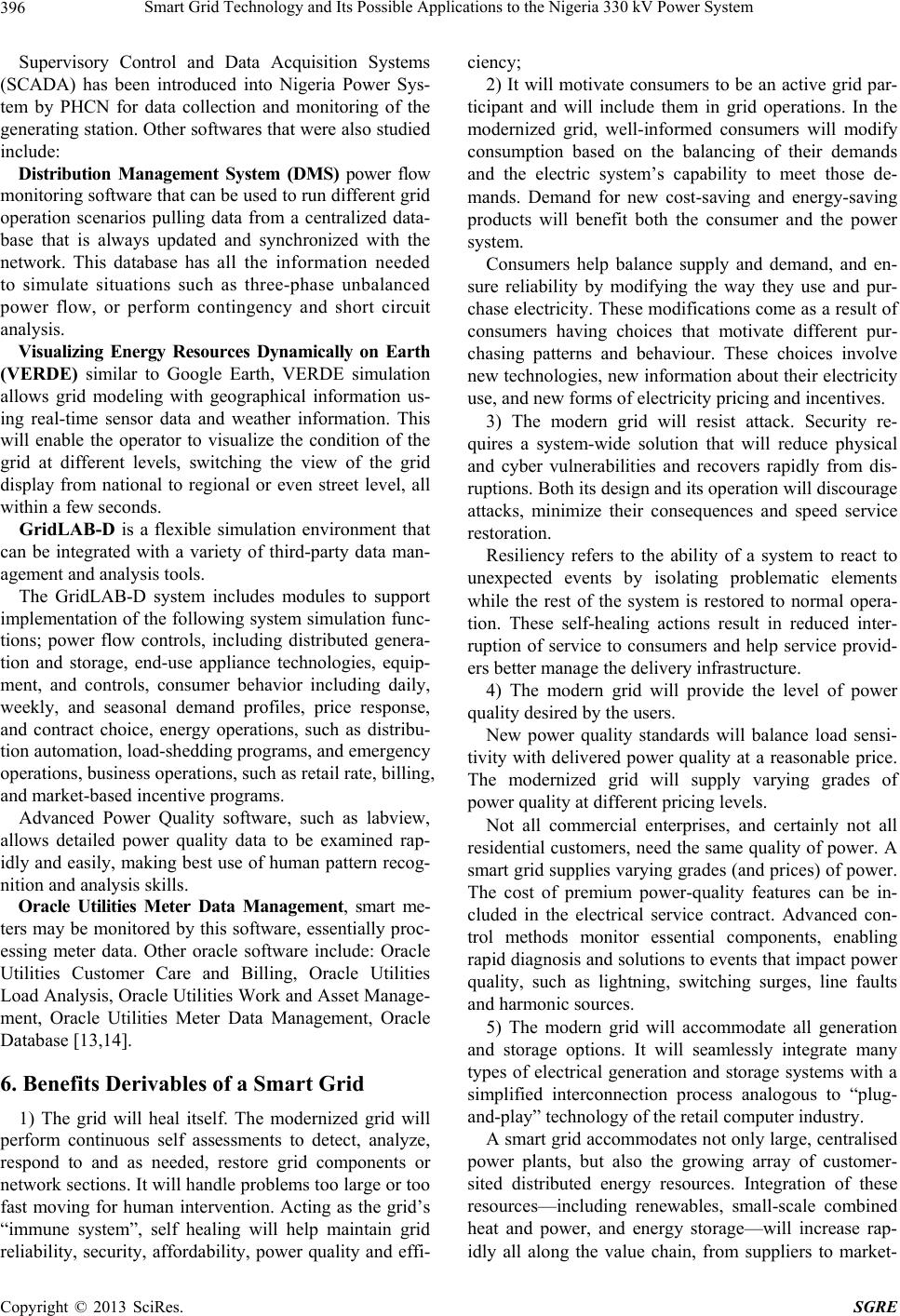 Smart Grid Technology and Its Possible Applications to the Nigeria 330 kV Power System Copyright © 2013 SciRes. SGRE 396 Supervisory Control and Data Acquisition Systems (SCADA) has been introduced into Nigeria Power Sys- tem by PHCN for data collection and monitoring of the generating station. Other softwares that were also studied include: Distribution Management System (DMS) power flow monitoring software that can be used to run different grid operation scenarios pulling data from a centralized data- base that is always updated and synchronized with the network. This database has all the information needed to simulate situations such as three-phase unbalanced power flow, or perform contingency and short circuit analysis. Visualizing Energy Resources Dynamically on Earth (VERDE) similar to Google Earth, VERDE simulation allows grid modeling with geographical information us- ing real-time sensor data and weather information. This will enable the operator to visualize the condition of the grid at different levels, switching the view of the grid display from national to regional or even street level, all within a few seconds. GridLAB-D is a flexible simulation environment that can be integrated with a variety of third-party data man- agement and analysis tools. The GridLAB-D system includes modules to support implementation of the following system simulatio n func- tions; power flow controls, including distributed genera- tion and storage, end-use appliance technologies, equip- ment, and controls, consumer behavior including daily, weekly, and seasonal demand profiles, price response, and contract choice, energy operations, such as distribu- tion automation, load-shedding programs, and emergency operations, business operations, such as retail rate, billing, and market-based incentive programs. Advanced Power Quality software, such as labview, allows detailed power quality data to be examined rap- idly and easily, making best use of human pattern recog- nition and an alysis skills. Oracle Utilities Meter Data Management, smart me- ters may be monitored by th is software, essentially proc- essing meter data. Other oracle software include: Oracle Utilities Customer Care and Billing, Oracle Utilities Load Analysis, Oracle Utilities Work and Asset Manage- ment, Oracle Utilities Meter Data Management, Oracle Database [13,14]. 6. Benefits Derivables of a Smart Grid 1) The grid will heal itself. The modernized grid will perform continuous self assessments to detect, analyze, respond to and as needed, restore grid components or network sections. It will handle p roblems too large or too fast moving for human intervention. Acting as the grid’s “immune system”, self healing will help maintain grid reliability, security, affordability, power quality and effi- ciency; 2) It will motivate consumers to be an active grid par- ticipant and will include them in grid operations. In the modernized grid, well-informed consumers will modify consumption based on the balancing of their demands and the electric system’s capability to meet those de- mands. Demand for new cost-saving and energy-saving products will benefit both the consumer and the power system. Consumers help balance supply and demand, and en- sure reliability by modifying the way they use and pur- chase electricity. These modifications come as a result of consumers having choices that motivate different pur- chasing patterns and behaviour. These choices involve new technologies, new information about their electricity use, and new forms of electricity pricing and incentives. 3) The modern grid will resist attack. Security re- quires a system-wide solution that will reduce physical and cyber vulnerabilities and recovers rapidly from dis- ruptions. Both its design and its operation will discourage attacks, minimize their consequences and speed service restoration. Resiliency refers to the ability of a system to react to unexpected events by isolating problematic elements while the rest of the system is restored to normal opera- tion. These self-healing actions result in reduced inter- ruption of service to consumers and help service provid- ers better manage the delivery infrastructure. 4) The modern grid will provide the level of power quality desired by the users. New power quality standards will balance load sensi- tivity with delivered power quality at a reasonable price. The modernized grid will supply varying grades of power quality at different pricing levels. Not all commercial enterprises, and certainly not all residential customers, need the same quality of power. A smart grid supplies varying grades (and prices) of power. The cost of premium power-quality features can be in- cluded in the electrical service contract. Advanced con- trol methods monitor essential components, enabling rapid diagnosis and solutions to events that impact power quality, such as lightning, switching surges, line faults and harmonic sources. 5) The modern grid will accommodate all generation and storage options. It will seamlessly integrate many types of electrical generation and storage systems with a simplified interconnection process analogous to “plug- and-play” technology of the retail computer industry. A smart grid accommodates not only large, centralised power plants, but also the growing array of customer- sited distributed energy resources. Integration of these resources—including renewables, small-scale combined heat and power, and energy storage—will increase rap- idly all along the value chain, from suppliers to market-  Smart Grid Technology and Its Possible Applications to the Nigeria 330 kV Power System Copyright © 2013 SciRes. SGRE 397 ers to customers. 6) The modern grid will enable markets to flourish. Open-access markets, expose and shed inefficiencies. The modern grid will enable more market participation through increased transmission paths, aggregated de- mand response initiatives and the placement of energy resources including storage within a more reliable distri- bution system that is closer to the consumer. Correctly designed and operated markets efficiently create an opportunity for consumers to choose among competing services. Some of the independent grid vari- ables that must be explicitly managed are energy, capac- ity, location, time, rate of change and quality. Markets can play a major role in the management of these vari- ables. Regulators, owners/operators and consumers need the flexibility to modify the rules of business to suit op- erating and market conditions. 7) Optimises asset utilisation and operating efficien- cy—A smart grid applies the latest technologies to opti- mise the use of its assets. For example, optimised capac- ity can be attainable with dynamic ratings, which allow assets to be used at greater loads by continuously sensing and rating their capacities. Maintenan ce efficiency can be optimised with condition-based maintenance, which sig- nals the need for equ ipment maintenance at precisely the right time. System-control devices can be adjusted to re- duce losses and eliminate congestion. Operating efficien- cy increases when selecting the least-cost energy-de- livery system available through these types of system- control devices [9,14]. 7. Conclusions We have seen that the present Nigerian grid is facing the problem of poorly maintained long transmission lines, inadequate communication facilities and insufficiency in power generation . We have proposed a method of supply reliability eva- luation for microgrids, including renewable energy sources, installation of elect ric e nergy st orage system s etc. Renewable energy is considered a viable solution to the energy challenges of Nigeria especially in the rural areas of the country and to the restrictions posed by the rising cost of conventional or traditional energy. The goal of a smart grid, as it relates to consumers, is to manage energy use more efficiently, save money on electricity, and provide technology and processes that are integrated in to the appliances and devices consumers use in their everyday lives, all without causing significant disruption. A successful smart grid will allow consumers to receive valuable and understandable information that enables them to make intelligent and informed choices about how they use energy, all while minimizing con- sumer cost and out-of-pocket expenses that could arise with the implementation of the smart grid. The willing- ness of consumers in Nigeria to accept and participate in the smart grid could be severely impaired if the cost outweighs the benefits. REFERENCES [1] P. Venkat and M. Saadat, “Smart Grid-Leveraging Intel- ligent Communicationsto Transform the Power Infra- structure,” Cisco Systems, Inc., 2009. [2] D. Von Dollen, “Report to NIST on the Smart Grid In- teroperability Standards Roadmap,” 2009. [3] J. Kuriakose, “Distributed Generation, Smart Grid and Micro Grid,” International Conference for Alternat ive Tech- nology, 2008. [4] “Smart Grid, Future Grid—A Basic Information Report on Smart Grid, Joint US-China Cooperation on Clean Energy (JUCCCE),” 2007. [5] Phcn, “Report on Generation Profile of the Country,” 2011. [6] A. S. Sambo, B. Garba, I. H. Zarma and M. M. Gaji- “Electricity Generation and the Present Challenges in the Nigerian Power Sector,” Energy Resources Review, Vol. 4, No. 3, 2003, pp. 7-10. [7] H. S. Labo (C.E.O TCN), “A Paper Presentation Current Status and Future Outlook of The Transmission Net- work,” Investor’s Forum for the Privatization of PHCN Successor Companies, 2010. [8] O. O. Sunday and O. O. Friday, “Empirical Modelling of Power Losses as a Function of Line Loadings and Lengths in the Nigerian 330 kV Transmission lines,” In- ternational Journal of Academic Research, Vol. 2, No. 3. 2010. [9] “Technology Road Map on Smart Grids,” International Energy Agency (IEA), 2011. [10] S. Abubakar, “Strategic Developments in Renewable Ener- gy in Nigeria,” International Association of Energy Eco- nomics, 2005. [11] Integration of Demand-Side Management, Distributed Ge- neration, “Renewable Energy Sources and Energy Stor- ages,” International Energy Agency Demand-Side Man- agement Programme (ieadsm), Finland, 2009. [12] “Gurlin Singh Lamba-Smart Grid and Its Development Prospects in the Asia-Pacific Region,” Journal of Emerg- ing Trends in Computing and Information Sciences, Vol. 2, No. 1, 2011. [13] “Oracle White Paper: Sma rt Grids-Strategic Planning and Development,” 2009. [14] Smart Grid by PDHengineer.com, Course no E-5006. http://www.pdhengineer.com/pages/E-5006.htm |

